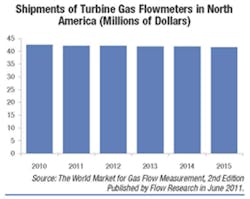Turbine Flowmeters: A Traditional Technology Learns Some New Tricks
Even though turbine flowmeters are losing ground to newtechnology flowmeters in some market segments, they remain a viable choice for steady, medium- to high-speed flows. Turbine meters have become solidly entrenched in the water, gas, oil and industrial liquid flow measurement markets.
Some turbine flowmeter companies are working hard to improve the technology and to make them more reliable. Important improvements address uni-directionality, pressure drop, fouling, sensitivity, and the need to lubricate turbine meters manually.
Three years ago Elster-Instromet launched the first bidirectional turbine meter, the SM-RI. According to Elster, it also reduces pressure loss by 50 percent over conventional turbine meters. The SM-RI is auto-lubricating. Elster claims its TurbinScope diagnostic tool makes it possible to examine performance under operating conditions without having to remove the meter from the process.The method, which is approved by the Dutch calibration facility NMi, can discover misreading due to turbine blade damage, installation effects, flow pulsations, and bearing damage. These capabilities mark an important step forward in turbine diagnostics.
Cox Instruments offers enhanced accuracy with its dual rotor turbine meters. A flow computer is used to compensate for changes in viscosity and rotor blade variations. Digital signal processing (DSP) is used to condition the output data.
Honeywell RMB’s TRZ for custody transfer turbine meter integrates the meter with a special counter that indicates flowing gas volumes at prevailing pressure and temperature conditions. Gas can flow either vertically or horizontally.
Spirax Sarco’s MassTracker is a multivariable insertion turbine meter. The MassTracker has an internal RTD and can measure mass flow without using a flow computer. Its hot-tap capability makes it usable for a wide range of line sizes. The MassTracker is designed for stack monitoring and district heating applications, among others.
Turbine flowmeters are still widely used in flowmeter calibration and laboratories because of their high accuracy. However, some turbine flowmeter companies report growth in applications such as aircraft flight, aerial refueling, and tactical foreign aircraft development. Other companies report growth in the oil and gas markets, cryogenic applications, and ultra-pure water processing.
Jesse Yoder
Jesse Yoder, Ph.D., is president of Flow Research Inc. He has 30 years of experience as an analyst and writer in instrumentation. Yoder holds two U.S. patents on a dual-tube meter design and is the author of "The Tao of Measurement," published by ISA. He may be reached at [email protected]. Find more information on the latest study from Flow Research, "The World Market for Gas Flow Measurement, 4th Edition," at www.gasflows.com.


